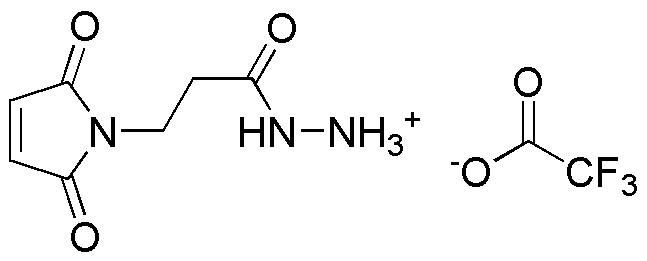b-Maleimidopropionic acid hydrazide is widely utilized in research focused on:
- Bioconjugation: This compound is often used to link biomolecules, such as proteins and antibodies, to other molecules for targeted drug delivery systems, enhancing the specificity and efficacy of treatments.
- Diagnostics: It plays a crucial role in the development of diagnostic tools, particularly in creating assays that can detect specific proteins or biomarkers in various diseases, improving early detection and treatment outcomes.
- Polymer Chemistry: In the field of materials science, it is employed to create functionalized polymers that can be used in coatings, adhesives, and other applications, providing enhanced mechanical properties and chemical resistance.
- Drug Development: This compound is instrumental in the synthesis of novel pharmaceuticals, particularly in the creation of hydrazone derivatives that exhibit promising biological activity, potentially leading to new therapeutic options.
- Research Reagents: It serves as a valuable reagent in various chemical reactions, facilitating the study of reaction mechanisms and the development of new synthetic pathways, thus advancing chemical research and innovation.
Informations générales
Propriétés
Sécurité et réglementation
Applications
b-Maleimidopropionic acid hydrazide is widely utilized in research focused on:
- Bioconjugation: This compound is often used to link biomolecules, such as proteins and antibodies, to other molecules for targeted drug delivery systems, enhancing the specificity and efficacy of treatments.
- Diagnostics: It plays a crucial role in the development of diagnostic tools, particularly in creating assays that can detect specific proteins or biomarkers in various diseases, improving early detection and treatment outcomes.
- Polymer Chemistry: In the field of materials science, it is employed to create functionalized polymers that can be used in coatings, adhesives, and other applications, providing enhanced mechanical properties and chemical resistance.
- Drug Development: This compound is instrumental in the synthesis of novel pharmaceuticals, particularly in the creation of hydrazone derivatives that exhibit promising biological activity, potentially leading to new therapeutic options.
- Research Reagents: It serves as a valuable reagent in various chemical reactions, facilitating the study of reaction mechanisms and the development of new synthetic pathways, thus advancing chemical research and innovation.
Documents
Fiches de données de sécurité (FDS)
La FDS fournit des informations de sécurité complètes sur la manipulation, le stockage et l’élimination du produit.
Spécifications du produit (PS)
Le PS fournit une description complète des propriétés du produit, notamment sa composition chimique, son état physique, sa pureté et les exigences de stockage. Il détaille également les plages de qualité acceptables et les applications prévues du produit.
Certificats d'analyse (COA)
Recherchez des certificats d'analyse (COA) en saisissant le numéro de lot du produit. Les numéros de lot et de lot se trouvent sur l'étiquette d'un produit, après les mots « Lot » ou « Lot de fabrication ».
Numéro de catalogue
Numéro de lot/série
Certificats d'origine (COO)
Ce certificat d'exploitation confirme le pays dans lequel le produit a été fabriqué, et détaille également les matériaux et composants utilisés et s'il est issu de sources naturelles, synthétiques ou autres sources spécifiques. Ce certificat peut être requis pour les douanes, le commerce et la conformité réglementaire.
Numéro de catalogue
Numéro de lot/série
Fiches de données de sécurité (FDS)
La FDS fournit des informations de sécurité complètes sur la manipulation, le stockage et l’élimination du produit.
DownloadSpécifications du produit (PS)
Le PS fournit une description complète des propriétés du produit, notamment sa composition chimique, son état physique, sa pureté et les exigences de stockage. Il détaille également les plages de qualité acceptables et les applications prévues du produit.
DownloadCertificats d'analyse (COA)
Recherchez des certificats d'analyse (COA) en saisissant le numéro de lot du produit. Les numéros de lot et de lot se trouvent sur l'étiquette d'un produit, après les mots « Lot » ou « Lot de fabrication ».
Numéro de catalogue
Numéro de lot/série
Certificats d'origine (COO)
Ce certificat d'exploitation confirme le pays dans lequel le produit a été fabriqué, et détaille également les matériaux et composants utilisés et s'il est issu de sources naturelles, synthétiques ou autres sources spécifiques. Ce certificat peut être requis pour les douanes, le commerce et la conformité réglementaire.

